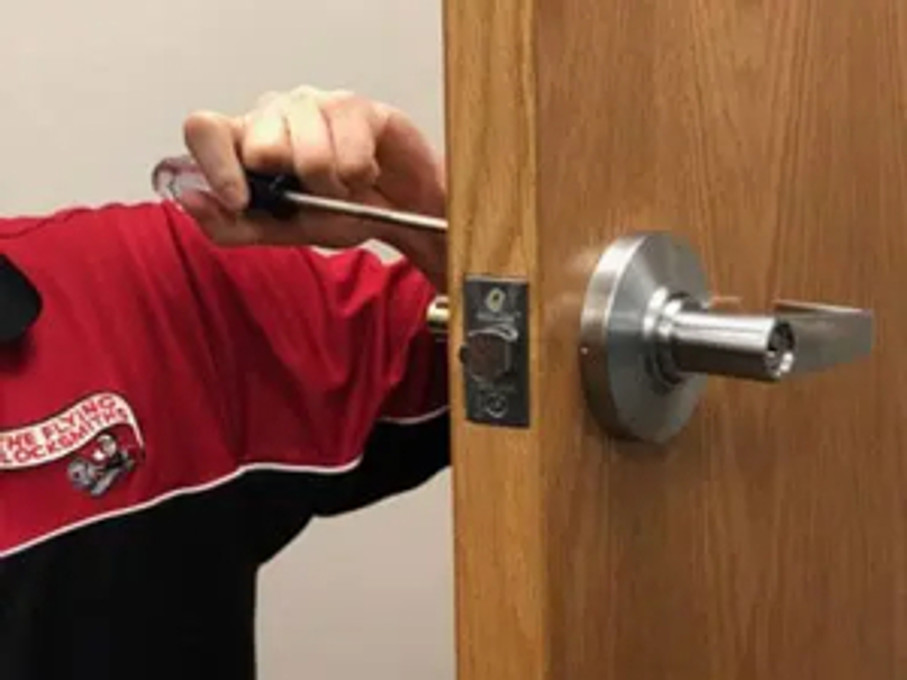
How to Change a Commercial Door Lock (Properly and Safely)
Posted by National Lock Supply on Oct 27th 2025
Replacing a commercial door lock may seem simple, but doing it correctly is crucial for security, smooth operation, and compliance with building codes. Whether you’re upgrading to a Grade 1 lockset or replacing worn hardware, the key is to choose the right replacement and install it with precision.
This guide explains how to change a commercial door lock step by step, including which tools you’ll need, when to call a professional, and how to maintain your new hardware for long-term reliability.
Before You Start: Identify the Lock Type
Commercial doors come in several formats, and identifying your lock type ensures you order the correct replacement.
- Cylindrical Locks: The most common type, installed through a 2-1/8" hole with a 1" latch bore.
- Mortise Locks: Built into a rectangular pocket within the door edge; typical for hospitals and schools.
- Deadbolts: Added for extra security, often combined with lever handles.
- Exit Devices (Panic Bars): Used on public or emergency doors; changing these requires code-approved components.
Look for the manufacturer name—Schlage, Yale, Sargent, or Corbin Russwin—on the latch, faceplate, or trim. That information helps match your existing door prep and keyway.
Tools and Materials You’ll Need
- Phillips and flat-head screwdrivers
- Allen wrench (for lever removal)
- Tape measure
- New commercial lockset
- Non-oil-based door lubricant
- Optional: power drill and bit set
Tip: Always check your backset (2-3/8" or 2-3/4") and door thickness (usually 1-3/4") before purchasing replacement hardware.
Step-by-Step: How to Replace a Commercial Door Lock
1. Remove the Old Lockset
Open the door and secure it. Unscrew the inside lever or knob using the appropriate tool—some use a small pin or set screw. Remove both sides of the handle and take out the latch screws. Gently pull out the old hardware.
2. Inspect the Door Prep
Check that the bore holes are clean, round, and aligned. If the strike plate or latch area shows wear, replace or reinforce it for better alignment.
3. Install the New Latch or Mortise Case
Slide the latchbolt or mortise body into the door edge, with the beveled side facing the jamb. Secure it with the provided screws—tight enough to hold but not over-torqued.
4. Mount the Exterior and Interior Trim
Align both sides of the handle through the latch mechanism. Insert and tighten the through-bolts evenly. Test the handle movement before fully tightening to ensure smooth operation.
5. Attach the Strike Plate
Install the strike plate on the frame, confirming latch engagement. Adjust slightly if the bolt doesn’t seat cleanly into the strike.
6. Test the Lock Operation
Close the door and test the lever, latch, and key function from both sides. If you’re installing an electrified or smart lock, follow the manufacturer’s wiring guide or hire a certified access control technician.
When to Call a Professional Locksmith
While most cylindrical lock replacements are manageable for maintenance staff, some situations call for a certified locksmith.
Tasks like mortise lock replacements, which require exact door prep, or rekeying and master key integrations, are best left to professionals. If you’re installing smart or electrified locks, a locksmith ensures correct wiring and system programming.
For fire-rated or code-regulated doors, professional installation is mandatory. A licensed locksmith guarantees that your hardware meets ANSI/BHMA and NFPA 101 Life Safety Code standards—protecting both your building and its occupants.
Choosing the Right Replacement Lock
Selecting the right commercial lock means matching its durability and security level to your facility’s needs.
Grade 1 hardware offers the highest strength and is ideal for main entrances and high-traffic areas, while Grade 2 locks are perfect for interior or light commercial use. Always check your keyway type—such as SC1 or KW1—to ensure compatibility with existing keys. Choose a finish like Satin Chrome or Oil-Rubbed Bronze for lasting corrosion resistance and aesthetic consistency.
Top manufacturers like Yale, Schlage, Corbin Russwin, Sargent, and Best Access provide hardware built for longevity and compliance. All are available through National Lock Supply, offering bulk pricing, same-day shipping, and expert support.
Maintenance Tips After Installation
Keeping your new lock in top shape ensures long-term performance. Apply a non-oil-based lubricant to moving parts twice a year to maintain smooth operation. Avoid graphite or grease—they attract dust and cause buildup.
Regularly check latch and strike alignment, especially on exterior doors that shift with temperature changes. Schedule professional rekeying or system audits annually for multi-user or high-security facilities.
Proper maintenance not only extends the life of your lock but also ensures it continues to meet code requirements and operate quietly every time.
Why Buy from National Lock Supply
When it’s time to upgrade your door hardware, National Lock Supply delivers dependable products, fast shipping, and knowledgeable support.
- Trusted Brands: Yale, Schlage, Sargent, Corbin Russwin, and Best Access.
- Bulk & Contractor Pricing: Save on multi-door or renovation projects.
- In-Stock Guarantee: Most models ship the same business day.
- U.S.-Based Expertise: Our specialists help confirm fit, finish, and keyway compatibility.
From single-door upgrades to large-scale facility projects, National Lock Supply is your partner for secure, code-compliant hardware that lasts.
FAQs
1. Can I change a commercial door lock myself?
Yes—if it’s a standard cylindrical lock and you have basic tools. Mortise, electrified, or fire-rated locks should be replaced by a professional locksmith.
2. How do I know which lock fits my door?
Measure your backset (2-3/8" or 2-3/4"), door thickness (usually 1-3/4"), and check the manufacturer name and model on the latch or trim. This ensures proper compatibility.
3. What’s the difference between Grade 1 and Grade 2 locks?
Grade 1 is the highest commercial rating for strength and durability, suitable for main entry and high-traffic doors. Grade 2 is intended for light commercial or interior applications.
4. Can I rekey my new commercial lock to match existing keys?
Yes. Most commercial locks with SC1 or KW1 keyways can be rekeyed by a locksmith to match your current system or master key plan.
5. How often should I maintain or rekey my commercial locks?
Lubricate locks twice a year and schedule annual rekeying for multi-user or secure areas. Regular upkeep ensures smooth function and continued compliance.
6. What are the best brands for commercial locks?
Trusted manufacturers include Yale, Schlage, Sargent, Corbin Russwin, and Best Access—all ANSI/BHMA certified and available through National Lock Supply.
7. When should I call a locksmith instead of doing it myself?
Call a locksmith for mortise or electrified locks, master keying, or fire-rated doors. These require code compliance and specialized tools for safe installation.
8. How long does it take to replace a commercial lock?
A typical cylindrical lock takes about 20–30 minutes to replace. Mortise or electronic locks may take longer, especially if wiring or alignment adjustments are needed.
 SAME DAY & EXPEDITED SHIPPING AVAILABLE
SAME DAY & EXPEDITED SHIPPING AVAILABLE





